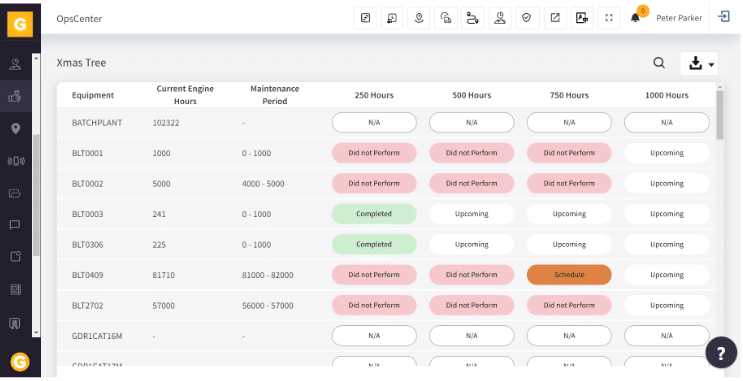Every mine manager worth his salt uses Heavy Equipment Availability and Utilization as one of primary KPIs (that, tonnes mined, and safety metrics). It is imperative that every maintenance team is compensated on the AVAILABILITY of mining equipment – especially your primary load/haul and your development equipment (e.g. Drills, Dozers, etc). However, maintaining these equipment fleets can be a significant challenge for mines and mining contractors.
The costs associated with maintenance, downtime, and safety risks can quickly escalate, impacting both profitability and productivity. Fortunately, with most OEMs now complying with the SAE j1939 standard, it has become incredibly easy for Maintenance Planners and Maintenance Supervisors to detect potential issues early and proactively schedule maintenance than wait for Operations to run the machine to the ground and then execute a down maintenance plan.
Equipment that has such sensors are said to be “Telemetry ready”. Most information such as the Engine Hours, etc are available for free – if you have the right type of Telemetry reader. Also know that although every OEM conforms to the SAE j1939 protocol, almost every OEM uses a slightly different type of port. Fortunately, companies such as ours, GroundHog, take the complexity out of the process and provides a unified platform to track such data across all mining OEMs.

Heavy equipment telemetry systems such as CAT VIMS and Komatsu VHMS involves the use of sensors, data collection devices, and communication systems to gather real-time information about the condition and performance of equipment. All of this data, including Engine Hours, Oil Temperatures and even fault codes, is shared on a CAN-bus. This information is then analyzed to enable proactive decision-making and optimization of maintenance practices. By leveraging telemetry, mines and mining contractors can significantly reduce maintenance costs while improving operational efficiency.
Challenges in heavy equipment maintenance
Maintaining heavy equipment in mining environments presents several challenges. At most places, maintenance technicians perform weekly inspections one equipment, and capture information such as SMU hours on a piece of paper. This data is then shared with supervisors that then enter it into massive Excel spreadsheets or into a maintenance ERP such as SAP. The labor costs, and the costs associated with repairs, spare parts, and labor can quickly become overwhelming. Additionally, unplanned equipment downtime can result in significant productivity losses, leading to missed deadlines and delayed project completion. Lastly, safety concerns arising from equipment failures pose risks to personnel and can result in accidents. Addressing these challenges requires a proactive approach to maintenance, which telemetry can facilitate.
Role of telemetry in heavy equipment maintenance
Telemetry, in the context of heavy equipment maintenance, refers to the continuous monitoring and collection of data regarding various parameters such as temperature, vibration, fluid levels, and usage statistics. This data is transmitted in real-time to a central system where it is analyzed and processed. Telemetry enables condition-based monitoring and predictive maintenance, helping identify potential issues before they escalate into costly failures.
Benefits of leveraging telemetry in heavy equipment maintenance
By implementing telemetry in heavy equipment maintenance, mines and mining contractors can experience several benefits.

Firstly, it allows for optimized maintenance schedules based on actual equipment conditions, reducing the need for unnecessary preventive maintenance. This leads to cost savings on parts, labor, and equipment downtime. Secondly, telemetry enables proactive identification of potential faults, allowing for timely repairs and minimizing equipment downtime. Lastly, by monitoring critical parameters, telemetry contributes to improved safety by identifying anomalies that could result in hazardous situations.
Implementing telemetry in heavy equipment maintenance
To leverage telemetry effectively, mines and mining contractors need to carefully select appropriate telemetry systems that are compatible with their equipment fleet. Once selected, these systems need to be installed and integrated seamlessly with the existing equipment infrastructure. Training programs should be conducted to ensure the workforce understands how to utilize telemetry data for decision-making and embraces the necessary changes in maintenance practices.
Overcoming challenges and limitations
While telemetry offers significant benefits, it also presents challenges that need to be addressed. One such challenge is the initial investment required for acquiring and implementing telemetry systems. However, the long-term cost savings and improved efficiency outweigh the upfront costs. Additionally, effective management and analysis of the vast amount of data generated by telemetry systems can be complex but can be addressed through appropriate data management strategies. Furthermore, ensuring data privacy and security is crucial to protect sensitive equipment information from potential cyber threats.
Future trends and advancements in telemetry for heavy equipment maintenance
The future of telemetry in heavy equipment maintenance looks promising.
To be honest, people have over-used the terms Big Data, Predictive Maintenance and AI for Maintenance these are all buzz words that have overpromised and woefully underdelivered that maintenance planners and maintenance superintendents now are extremely wary whenever someone utters these words
Advancements in artificial intelligence and machine learning algorithms will enhance the ability to detect patterns and anomalies in telemetry data, enabling more accurate predictive maintenance. Integration with other technologies, such as the Internet of Things (IoT), will further expand the capabilities of telemetry systems. These advancements have the potential to revolutionize the mining industry by significantly reducing maintenance costs and improving operational efficiency.
In conclusion, leveraging telemetry in heavy equipment maintenance is a game-changer for mines and mining contractors. It allows for cost-effective maintenance practices, reduces downtime, and improves safety.
By embracing telemetry, you as a maintenance superintendent can achieve significant cost savings, enhance productivity, and gain a competitive edge in the industry. The benefits of implementing telemetry outweigh the challenges, making it an essential tool for the modern mining industry.
Leveraging telemetry to develop a proactive maintenance program has many benefits. Your machines are constantly giving out information about the health of their systems. Why not listen? There are many options on the market for telemetry systems that are purpose-built for mining environments, and compatible regardless of your type or brand of machine.
The right Telemetry and Maintenance Management system can provide more than just ROI. It can empower your team to maximize revenues with actionable insights.
Information is power, and making data informed choices will keep your team driving towards your company’s goals.
To learn about telemetry –https://groundhogapps.com/groundhog-mining-fleet-management/
Do Follow our LinkedIn Newsletters-
https://www.linkedin.com/newsletters/digging-deeper-mining-tech-7016633803062358016/
https://www.linkedin.com/newsletters/mine-digitization-automation-6924713123673235456/


